7156EDN Assignment 2: Coordinated CET Approach and Models
VerifiedAdded on 2022/12/08
|19
|5590
|254
Report
AI Summary
This report examines the effectiveness of continuing education and training (CET) through both workplace learning and vocational education and training (VET) classrooms. It compares learning in educational institutions and the workplace, highlighting the barriers to informal learning and the importance of preparing professionals for emerging jobs, such as those related to artificial intelligence and robotics. The report analyzes a case study of employees at Weatherzone, recommending a "work-based with educational interventions" model that combines workplace and VET learning. It emphasizes the need for collaboration between businesses and VET schools to develop a skilled workforce capable of handling advanced technologies and addressing the challenges of the fourth industrial revolution. The report provides a comprehensive description of the selected group of workers, their CET needs, and the benefits of the recommended model for Weatherzone, including the use of artificial intelligence and data analysis. The report also highlights the importance of job-based training, strategic collaborations with VET schools, and the need for industry leaders and educators to adapt learning curricula to meet the demands of the evolving technological landscape. The report concludes with recommendations and justification for the selected model. The report is a valuable resource for students and professionals seeking to enhance their understanding of effective training programs, particularly those related to workplace learning.
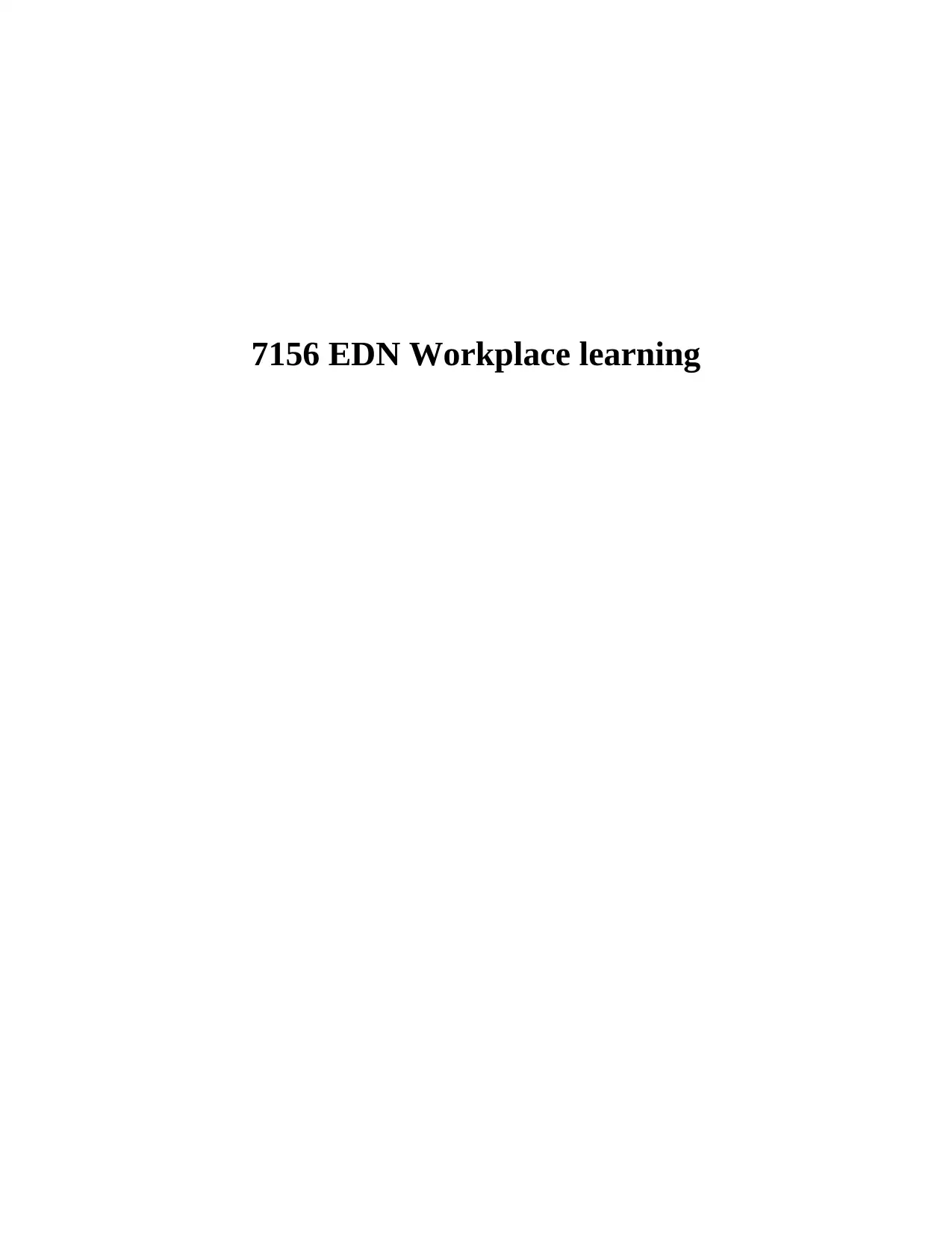
7156 EDN Workplace learning
Paraphrase This Document
Need a fresh take? Get an instant paraphrase of this document with our AI Paraphraser
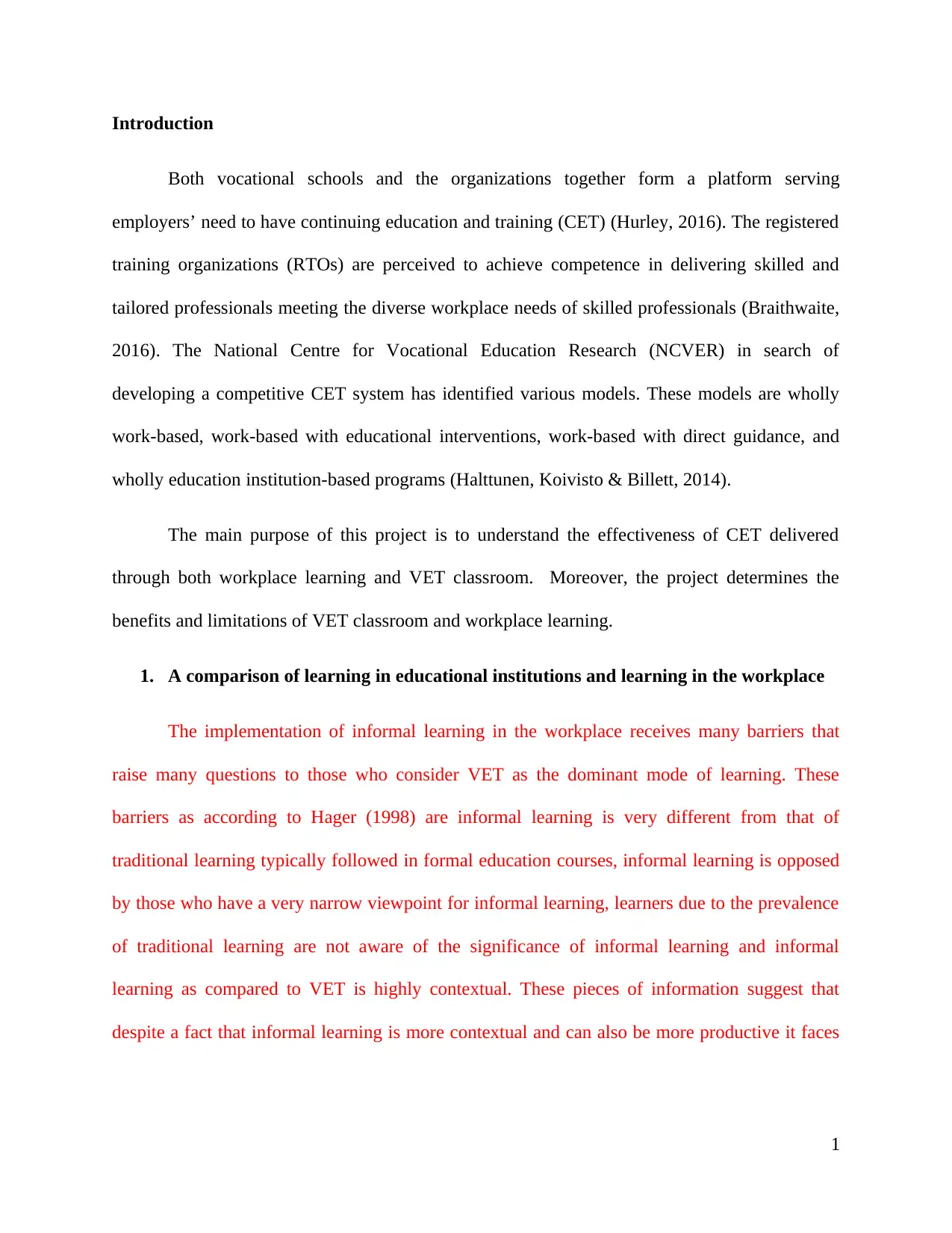
Introduction
Both vocational schools and the organizations together form a platform serving
employers’ need to have continuing education and training (CET) (Hurley, 2016). The registered
training organizations (RTOs) are perceived to achieve competence in delivering skilled and
tailored professionals meeting the diverse workplace needs of skilled professionals (Braithwaite,
2016). The National Centre for Vocational Education Research (NCVER) in search of
developing a competitive CET system has identified various models. These models are wholly
work-based, work-based with educational interventions, work-based with direct guidance, and
wholly education institution-based programs (Halttunen, Koivisto & Billett, 2014).
The main purpose of this project is to understand the effectiveness of CET delivered
through both workplace learning and VET classroom. Moreover, the project determines the
benefits and limitations of VET classroom and workplace learning.
1. A comparison of learning in educational institutions and learning in the workplace
The implementation of informal learning in the workplace receives many barriers that
raise many questions to those who consider VET as the dominant mode of learning. These
barriers as according to Hager (1998) are informal learning is very different from that of
traditional learning typically followed in formal education courses, informal learning is opposed
by those who have a very narrow viewpoint for informal learning, learners due to the prevalence
of traditional learning are not aware of the significance of informal learning and informal
learning as compared to VET is highly contextual. These pieces of information suggest that
despite a fact that informal learning is more contextual and can also be more productive it faces
1
Both vocational schools and the organizations together form a platform serving
employers’ need to have continuing education and training (CET) (Hurley, 2016). The registered
training organizations (RTOs) are perceived to achieve competence in delivering skilled and
tailored professionals meeting the diverse workplace needs of skilled professionals (Braithwaite,
2016). The National Centre for Vocational Education Research (NCVER) in search of
developing a competitive CET system has identified various models. These models are wholly
work-based, work-based with educational interventions, work-based with direct guidance, and
wholly education institution-based programs (Halttunen, Koivisto & Billett, 2014).
The main purpose of this project is to understand the effectiveness of CET delivered
through both workplace learning and VET classroom. Moreover, the project determines the
benefits and limitations of VET classroom and workplace learning.
1. A comparison of learning in educational institutions and learning in the workplace
The implementation of informal learning in the workplace receives many barriers that
raise many questions to those who consider VET as the dominant mode of learning. These
barriers as according to Hager (1998) are informal learning is very different from that of
traditional learning typically followed in formal education courses, informal learning is opposed
by those who have a very narrow viewpoint for informal learning, learners due to the prevalence
of traditional learning are not aware of the significance of informal learning and informal
learning as compared to VET is highly contextual. These pieces of information suggest that
despite a fact that informal learning is more contextual and can also be more productive it faces
1
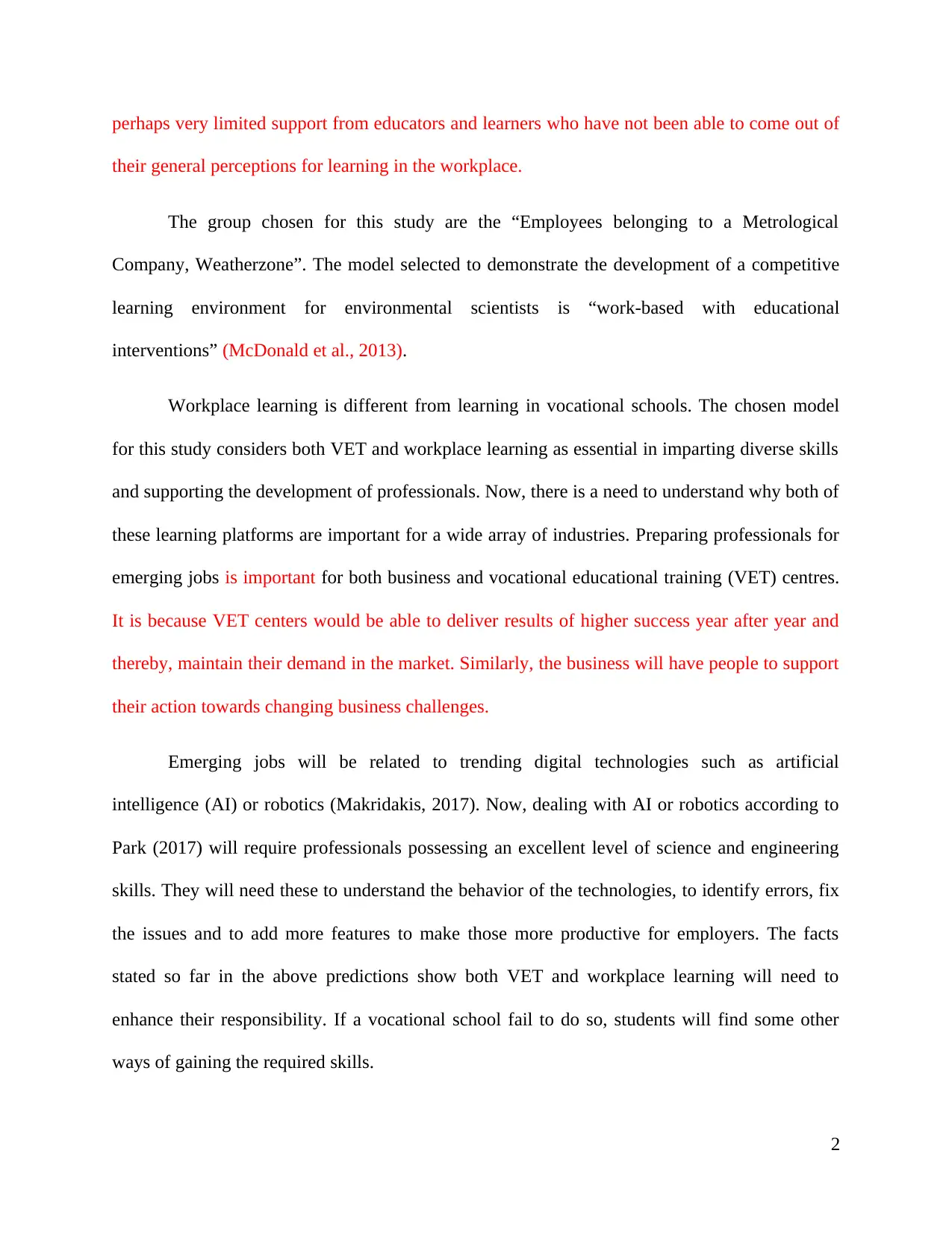
perhaps very limited support from educators and learners who have not been able to come out of
their general perceptions for learning in the workplace.
The group chosen for this study are the “Employees belonging to a Metrological
Company, Weatherzone”. The model selected to demonstrate the development of a competitive
learning environment for environmental scientists is “work-based with educational
interventions” (McDonald et al., 2013).
Workplace learning is different from learning in vocational schools. The chosen model
for this study considers both VET and workplace learning as essential in imparting diverse skills
and supporting the development of professionals. Now, there is a need to understand why both of
these learning platforms are important for a wide array of industries. Preparing professionals for
emerging jobs is important for both business and vocational educational training (VET) centres.
It is because VET centers would be able to deliver results of higher success year after year and
thereby, maintain their demand in the market. Similarly, the business will have people to support
their action towards changing business challenges.
Emerging jobs will be related to trending digital technologies such as artificial
intelligence (AI) or robotics (Makridakis, 2017). Now, dealing with AI or robotics according to
Park (2017) will require professionals possessing an excellent level of science and engineering
skills. They will need these to understand the behavior of the technologies, to identify errors, fix
the issues and to add more features to make those more productive for employers. The facts
stated so far in the above predictions show both VET and workplace learning will need to
enhance their responsibility. If a vocational school fail to do so, students will find some other
ways of gaining the required skills.
2
their general perceptions for learning in the workplace.
The group chosen for this study are the “Employees belonging to a Metrological
Company, Weatherzone”. The model selected to demonstrate the development of a competitive
learning environment for environmental scientists is “work-based with educational
interventions” (McDonald et al., 2013).
Workplace learning is different from learning in vocational schools. The chosen model
for this study considers both VET and workplace learning as essential in imparting diverse skills
and supporting the development of professionals. Now, there is a need to understand why both of
these learning platforms are important for a wide array of industries. Preparing professionals for
emerging jobs is important for both business and vocational educational training (VET) centres.
It is because VET centers would be able to deliver results of higher success year after year and
thereby, maintain their demand in the market. Similarly, the business will have people to support
their action towards changing business challenges.
Emerging jobs will be related to trending digital technologies such as artificial
intelligence (AI) or robotics (Makridakis, 2017). Now, dealing with AI or robotics according to
Park (2017) will require professionals possessing an excellent level of science and engineering
skills. They will need these to understand the behavior of the technologies, to identify errors, fix
the issues and to add more features to make those more productive for employers. The facts
stated so far in the above predictions show both VET and workplace learning will need to
enhance their responsibility. If a vocational school fail to do so, students will find some other
ways of gaining the required skills.
2
⊘ This is a preview!⊘
Do you want full access?
Subscribe today to unlock all pages.

Trusted by 1+ million students worldwide
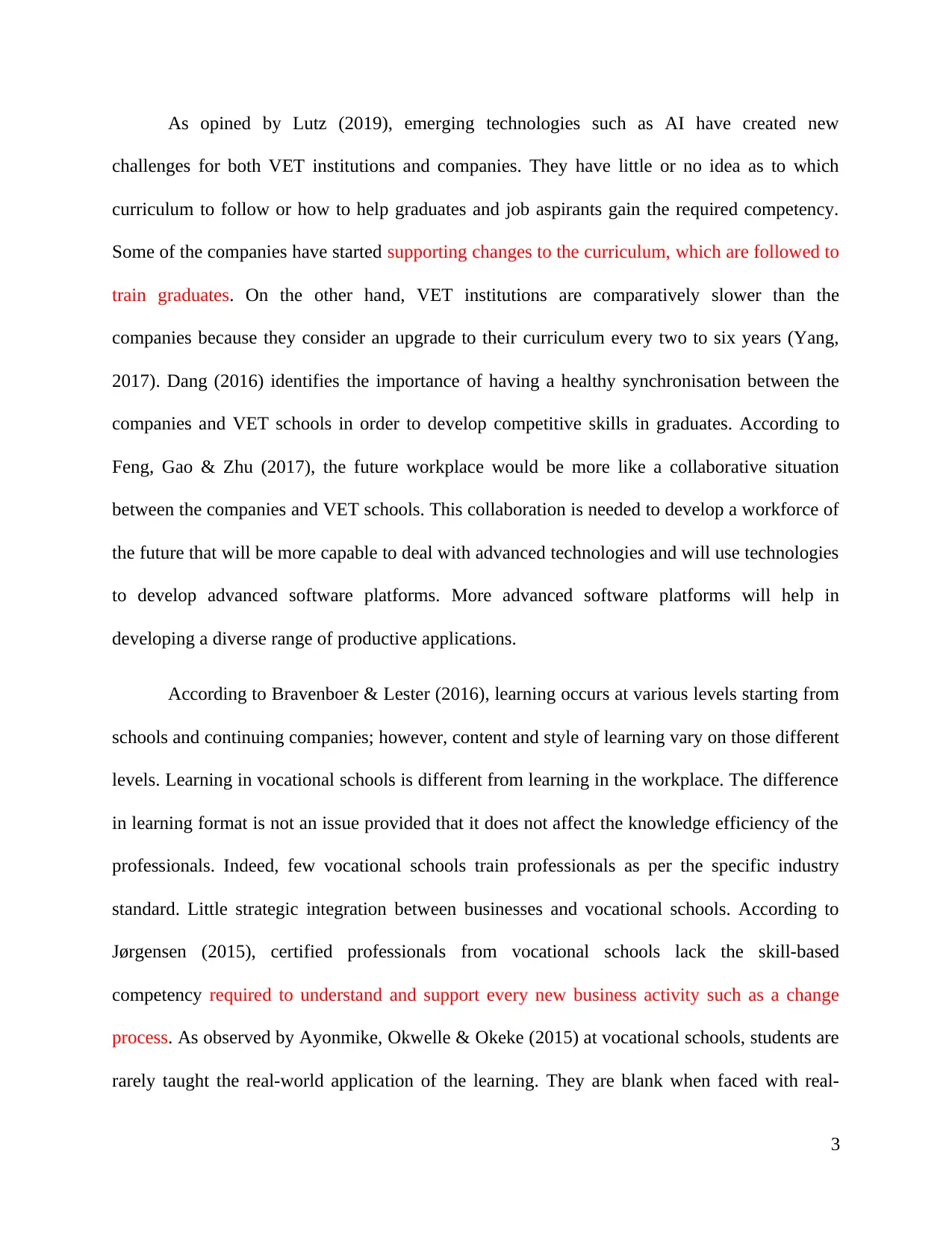
As opined by Lutz (2019), emerging technologies such as AI have created new
challenges for both VET institutions and companies. They have little or no idea as to which
curriculum to follow or how to help graduates and job aspirants gain the required competency.
Some of the companies have started supporting changes to the curriculum, which are followed to
train graduates. On the other hand, VET institutions are comparatively slower than the
companies because they consider an upgrade to their curriculum every two to six years (Yang,
2017). Dang (2016) identifies the importance of having a healthy synchronisation between the
companies and VET schools in order to develop competitive skills in graduates. According to
Feng, Gao & Zhu (2017), the future workplace would be more like a collaborative situation
between the companies and VET schools. This collaboration is needed to develop a workforce of
the future that will be more capable to deal with advanced technologies and will use technologies
to develop advanced software platforms. More advanced software platforms will help in
developing a diverse range of productive applications.
According to Bravenboer & Lester (2016), learning occurs at various levels starting from
schools and continuing companies; however, content and style of learning vary on those different
levels. Learning in vocational schools is different from learning in the workplace. The difference
in learning format is not an issue provided that it does not affect the knowledge efficiency of the
professionals. Indeed, few vocational schools train professionals as per the specific industry
standard. Little strategic integration between businesses and vocational schools. According to
Jørgensen (2015), certified professionals from vocational schools lack the skill-based
competency required to understand and support every new business activity such as a change
process. As observed by Ayonmike, Okwelle & Okeke (2015) at vocational schools, students are
rarely taught the real-world application of the learning. They are blank when faced with real-
3
challenges for both VET institutions and companies. They have little or no idea as to which
curriculum to follow or how to help graduates and job aspirants gain the required competency.
Some of the companies have started supporting changes to the curriculum, which are followed to
train graduates. On the other hand, VET institutions are comparatively slower than the
companies because they consider an upgrade to their curriculum every two to six years (Yang,
2017). Dang (2016) identifies the importance of having a healthy synchronisation between the
companies and VET schools in order to develop competitive skills in graduates. According to
Feng, Gao & Zhu (2017), the future workplace would be more like a collaborative situation
between the companies and VET schools. This collaboration is needed to develop a workforce of
the future that will be more capable to deal with advanced technologies and will use technologies
to develop advanced software platforms. More advanced software platforms will help in
developing a diverse range of productive applications.
According to Bravenboer & Lester (2016), learning occurs at various levels starting from
schools and continuing companies; however, content and style of learning vary on those different
levels. Learning in vocational schools is different from learning in the workplace. The difference
in learning format is not an issue provided that it does not affect the knowledge efficiency of the
professionals. Indeed, few vocational schools train professionals as per the specific industry
standard. Little strategic integration between businesses and vocational schools. According to
Jørgensen (2015), certified professionals from vocational schools lack the skill-based
competency required to understand and support every new business activity such as a change
process. As observed by Ayonmike, Okwelle & Okeke (2015) at vocational schools, students are
rarely taught the real-world application of the learning. They are blank when faced with real-
3
Paraphrase This Document
Need a fresh take? Get an instant paraphrase of this document with our AI Paraphraser
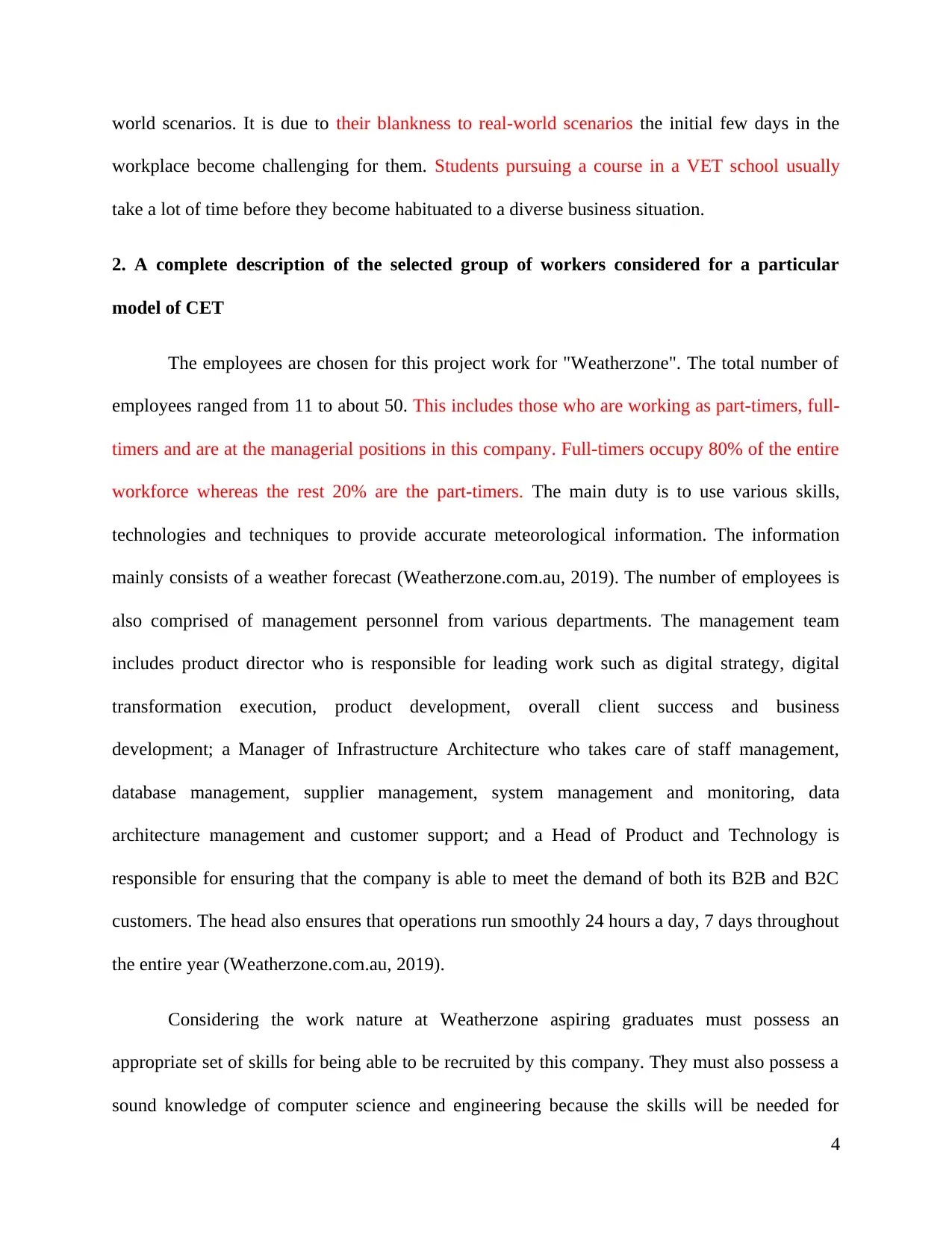
world scenarios. It is due to their blankness to real-world scenarios the initial few days in the
workplace become challenging for them. Students pursuing a course in a VET school usually
take a lot of time before they become habituated to a diverse business situation.
2. A complete description of the selected group of workers considered for a particular
model of CET
The employees are chosen for this project work for "Weatherzone". The total number of
employees ranged from 11 to about 50. This includes those who are working as part-timers, full-
timers and are at the managerial positions in this company. Full-timers occupy 80% of the entire
workforce whereas the rest 20% are the part-timers. The main duty is to use various skills,
technologies and techniques to provide accurate meteorological information. The information
mainly consists of a weather forecast (Weatherzone.com.au, 2019). The number of employees is
also comprised of management personnel from various departments. The management team
includes product director who is responsible for leading work such as digital strategy, digital
transformation execution, product development, overall client success and business
development; a Manager of Infrastructure Architecture who takes care of staff management,
database management, supplier management, system management and monitoring, data
architecture management and customer support; and a Head of Product and Technology is
responsible for ensuring that the company is able to meet the demand of both its B2B and B2C
customers. The head also ensures that operations run smoothly 24 hours a day, 7 days throughout
the entire year (Weatherzone.com.au, 2019).
Considering the work nature at Weatherzone aspiring graduates must possess an
appropriate set of skills for being able to be recruited by this company. They must also possess a
sound knowledge of computer science and engineering because the skills will be needed for
4
workplace become challenging for them. Students pursuing a course in a VET school usually
take a lot of time before they become habituated to a diverse business situation.
2. A complete description of the selected group of workers considered for a particular
model of CET
The employees are chosen for this project work for "Weatherzone". The total number of
employees ranged from 11 to about 50. This includes those who are working as part-timers, full-
timers and are at the managerial positions in this company. Full-timers occupy 80% of the entire
workforce whereas the rest 20% are the part-timers. The main duty is to use various skills,
technologies and techniques to provide accurate meteorological information. The information
mainly consists of a weather forecast (Weatherzone.com.au, 2019). The number of employees is
also comprised of management personnel from various departments. The management team
includes product director who is responsible for leading work such as digital strategy, digital
transformation execution, product development, overall client success and business
development; a Manager of Infrastructure Architecture who takes care of staff management,
database management, supplier management, system management and monitoring, data
architecture management and customer support; and a Head of Product and Technology is
responsible for ensuring that the company is able to meet the demand of both its B2B and B2C
customers. The head also ensures that operations run smoothly 24 hours a day, 7 days throughout
the entire year (Weatherzone.com.au, 2019).
Considering the work nature at Weatherzone aspiring graduates must possess an
appropriate set of skills for being able to be recruited by this company. They must also possess a
sound knowledge of computer science and engineering because the skills will be needed for
4
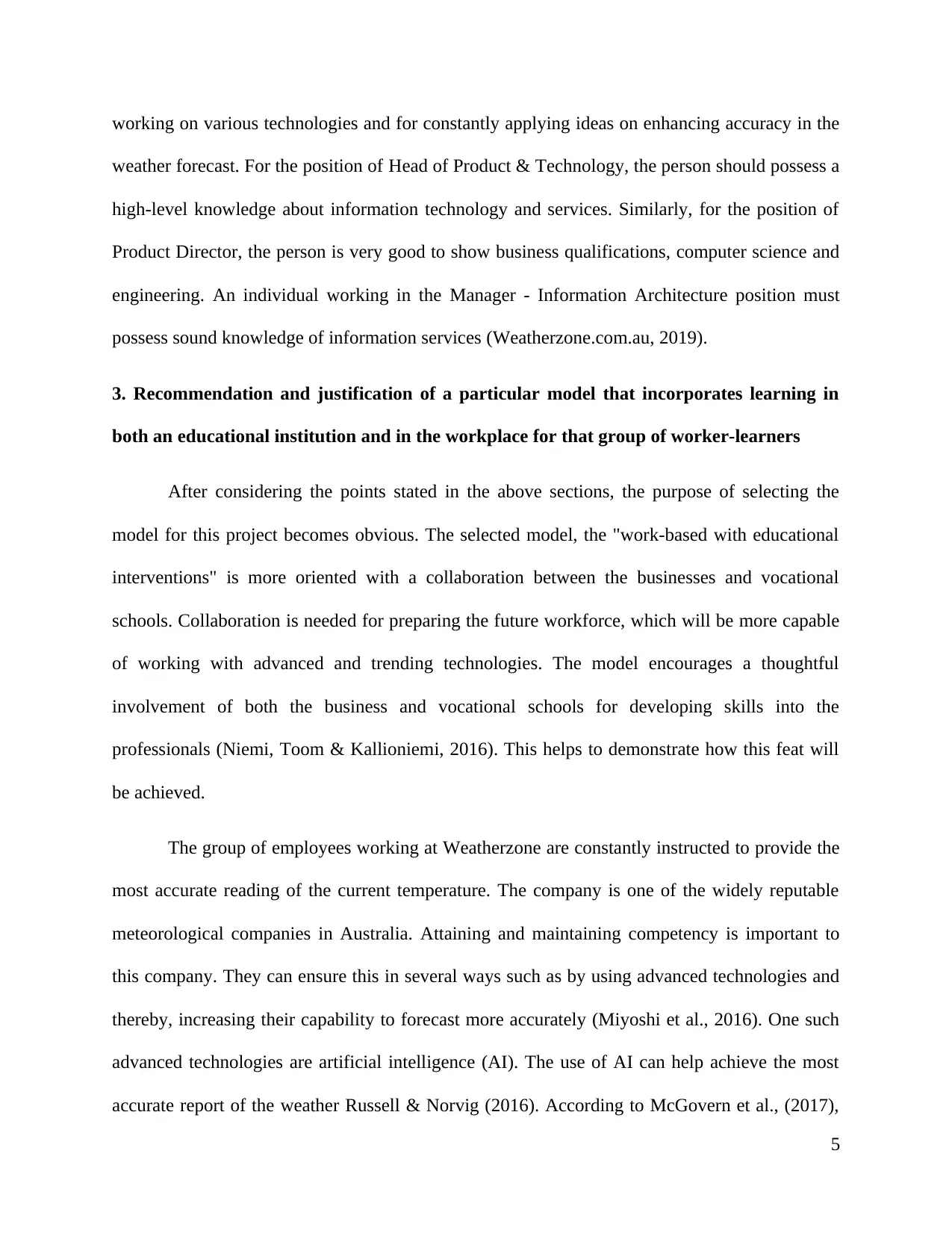
working on various technologies and for constantly applying ideas on enhancing accuracy in the
weather forecast. For the position of Head of Product & Technology, the person should possess a
high-level knowledge about information technology and services. Similarly, for the position of
Product Director, the person is very good to show business qualifications, computer science and
engineering. An individual working in the Manager - Information Architecture position must
possess sound knowledge of information services (Weatherzone.com.au, 2019).
3. Recommendation and justification of a particular model that incorporates learning in
both an educational institution and in the workplace for that group of worker-learners
After considering the points stated in the above sections, the purpose of selecting the
model for this project becomes obvious. The selected model, the "work-based with educational
interventions" is more oriented with a collaboration between the businesses and vocational
schools. Collaboration is needed for preparing the future workforce, which will be more capable
of working with advanced and trending technologies. The model encourages a thoughtful
involvement of both the business and vocational schools for developing skills into the
professionals (Niemi, Toom & Kallioniemi, 2016). This helps to demonstrate how this feat will
be achieved.
The group of employees working at Weatherzone are constantly instructed to provide the
most accurate reading of the current temperature. The company is one of the widely reputable
meteorological companies in Australia. Attaining and maintaining competency is important to
this company. They can ensure this in several ways such as by using advanced technologies and
thereby, increasing their capability to forecast more accurately (Miyoshi et al., 2016). One such
advanced technologies are artificial intelligence (AI). The use of AI can help achieve the most
accurate report of the weather Russell & Norvig (2016). According to McGovern et al., (2017),
5
weather forecast. For the position of Head of Product & Technology, the person should possess a
high-level knowledge about information technology and services. Similarly, for the position of
Product Director, the person is very good to show business qualifications, computer science and
engineering. An individual working in the Manager - Information Architecture position must
possess sound knowledge of information services (Weatherzone.com.au, 2019).
3. Recommendation and justification of a particular model that incorporates learning in
both an educational institution and in the workplace for that group of worker-learners
After considering the points stated in the above sections, the purpose of selecting the
model for this project becomes obvious. The selected model, the "work-based with educational
interventions" is more oriented with a collaboration between the businesses and vocational
schools. Collaboration is needed for preparing the future workforce, which will be more capable
of working with advanced and trending technologies. The model encourages a thoughtful
involvement of both the business and vocational schools for developing skills into the
professionals (Niemi, Toom & Kallioniemi, 2016). This helps to demonstrate how this feat will
be achieved.
The group of employees working at Weatherzone are constantly instructed to provide the
most accurate reading of the current temperature. The company is one of the widely reputable
meteorological companies in Australia. Attaining and maintaining competency is important to
this company. They can ensure this in several ways such as by using advanced technologies and
thereby, increasing their capability to forecast more accurately (Miyoshi et al., 2016). One such
advanced technologies are artificial intelligence (AI). The use of AI can help achieve the most
accurate report of the weather Russell & Norvig (2016). According to McGovern et al., (2017),
5
⊘ This is a preview!⊘
Do you want full access?
Subscribe today to unlock all pages.

Trusted by 1+ million students worldwide
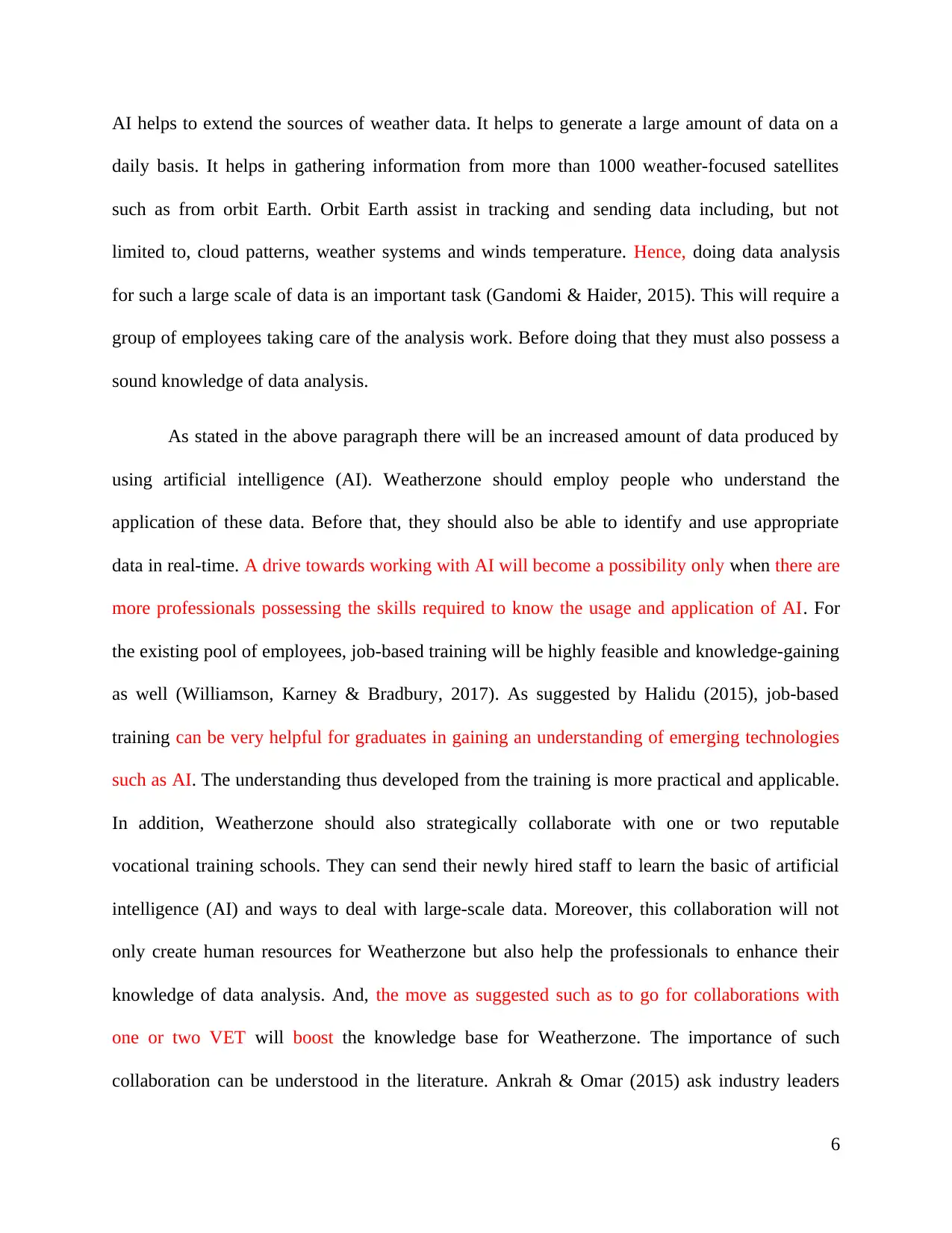
AI helps to extend the sources of weather data. It helps to generate a large amount of data on a
daily basis. It helps in gathering information from more than 1000 weather-focused satellites
such as from orbit Earth. Orbit Earth assist in tracking and sending data including, but not
limited to, cloud patterns, weather systems and winds temperature. Hence, doing data analysis
for such a large scale of data is an important task (Gandomi & Haider, 2015). This will require a
group of employees taking care of the analysis work. Before doing that they must also possess a
sound knowledge of data analysis.
As stated in the above paragraph there will be an increased amount of data produced by
using artificial intelligence (AI). Weatherzone should employ people who understand the
application of these data. Before that, they should also be able to identify and use appropriate
data in real-time. A drive towards working with AI will become a possibility only when there are
more professionals possessing the skills required to know the usage and application of AI. For
the existing pool of employees, job-based training will be highly feasible and knowledge-gaining
as well (Williamson, Karney & Bradbury, 2017). As suggested by Halidu (2015), job-based
training can be very helpful for graduates in gaining an understanding of emerging technologies
such as AI. The understanding thus developed from the training is more practical and applicable.
In addition, Weatherzone should also strategically collaborate with one or two reputable
vocational training schools. They can send their newly hired staff to learn the basic of artificial
intelligence (AI) and ways to deal with large-scale data. Moreover, this collaboration will not
only create human resources for Weatherzone but also help the professionals to enhance their
knowledge of data analysis. And, the move as suggested such as to go for collaborations with
one or two VET will boost the knowledge base for Weatherzone. The importance of such
collaboration can be understood in the literature. Ankrah & Omar (2015) ask industry leaders
6
daily basis. It helps in gathering information from more than 1000 weather-focused satellites
such as from orbit Earth. Orbit Earth assist in tracking and sending data including, but not
limited to, cloud patterns, weather systems and winds temperature. Hence, doing data analysis
for such a large scale of data is an important task (Gandomi & Haider, 2015). This will require a
group of employees taking care of the analysis work. Before doing that they must also possess a
sound knowledge of data analysis.
As stated in the above paragraph there will be an increased amount of data produced by
using artificial intelligence (AI). Weatherzone should employ people who understand the
application of these data. Before that, they should also be able to identify and use appropriate
data in real-time. A drive towards working with AI will become a possibility only when there are
more professionals possessing the skills required to know the usage and application of AI. For
the existing pool of employees, job-based training will be highly feasible and knowledge-gaining
as well (Williamson, Karney & Bradbury, 2017). As suggested by Halidu (2015), job-based
training can be very helpful for graduates in gaining an understanding of emerging technologies
such as AI. The understanding thus developed from the training is more practical and applicable.
In addition, Weatherzone should also strategically collaborate with one or two reputable
vocational training schools. They can send their newly hired staff to learn the basic of artificial
intelligence (AI) and ways to deal with large-scale data. Moreover, this collaboration will not
only create human resources for Weatherzone but also help the professionals to enhance their
knowledge of data analysis. And, the move as suggested such as to go for collaborations with
one or two VET will boost the knowledge base for Weatherzone. The importance of such
collaboration can be understood in the literature. Ankrah & Omar (2015) ask industry leaders
6
Paraphrase This Document
Need a fresh take? Get an instant paraphrase of this document with our AI Paraphraser
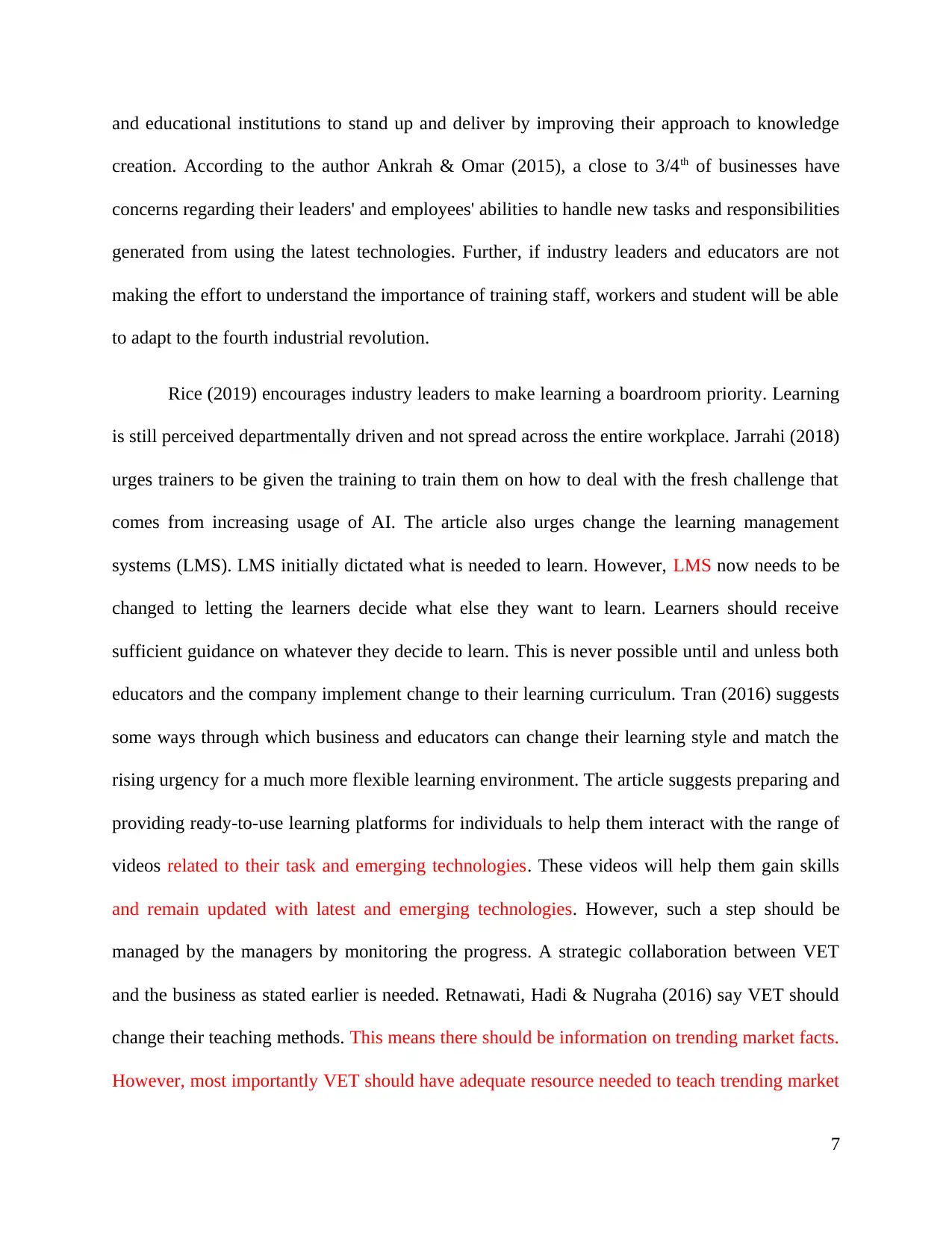
and educational institutions to stand up and deliver by improving their approach to knowledge
creation. According to the author Ankrah & Omar (2015), a close to 3/4th of businesses have
concerns regarding their leaders' and employees' abilities to handle new tasks and responsibilities
generated from using the latest technologies. Further, if industry leaders and educators are not
making the effort to understand the importance of training staff, workers and student will be able
to adapt to the fourth industrial revolution.
Rice (2019) encourages industry leaders to make learning a boardroom priority. Learning
is still perceived departmentally driven and not spread across the entire workplace. Jarrahi (2018)
urges trainers to be given the training to train them on how to deal with the fresh challenge that
comes from increasing usage of AI. The article also urges change the learning management
systems (LMS). LMS initially dictated what is needed to learn. However, LMS now needs to be
changed to letting the learners decide what else they want to learn. Learners should receive
sufficient guidance on whatever they decide to learn. This is never possible until and unless both
educators and the company implement change to their learning curriculum. Tran (2016) suggests
some ways through which business and educators can change their learning style and match the
rising urgency for a much more flexible learning environment. The article suggests preparing and
providing ready-to-use learning platforms for individuals to help them interact with the range of
videos related to their task and emerging technologies. These videos will help them gain skills
and remain updated with latest and emerging technologies. However, such a step should be
managed by the managers by monitoring the progress. A strategic collaboration between VET
and the business as stated earlier is needed. Retnawati, Hadi & Nugraha (2016) say VET should
change their teaching methods. This means there should be information on trending market facts.
However, most importantly VET should have adequate resource needed to teach trending market
7
creation. According to the author Ankrah & Omar (2015), a close to 3/4th of businesses have
concerns regarding their leaders' and employees' abilities to handle new tasks and responsibilities
generated from using the latest technologies. Further, if industry leaders and educators are not
making the effort to understand the importance of training staff, workers and student will be able
to adapt to the fourth industrial revolution.
Rice (2019) encourages industry leaders to make learning a boardroom priority. Learning
is still perceived departmentally driven and not spread across the entire workplace. Jarrahi (2018)
urges trainers to be given the training to train them on how to deal with the fresh challenge that
comes from increasing usage of AI. The article also urges change the learning management
systems (LMS). LMS initially dictated what is needed to learn. However, LMS now needs to be
changed to letting the learners decide what else they want to learn. Learners should receive
sufficient guidance on whatever they decide to learn. This is never possible until and unless both
educators and the company implement change to their learning curriculum. Tran (2016) suggests
some ways through which business and educators can change their learning style and match the
rising urgency for a much more flexible learning environment. The article suggests preparing and
providing ready-to-use learning platforms for individuals to help them interact with the range of
videos related to their task and emerging technologies. These videos will help them gain skills
and remain updated with latest and emerging technologies. However, such a step should be
managed by the managers by monitoring the progress. A strategic collaboration between VET
and the business as stated earlier is needed. Retnawati, Hadi & Nugraha (2016) say VET should
change their teaching methods. This means there should be information on trending market facts.
However, most importantly VET should have adequate resource needed to teach trending market
7
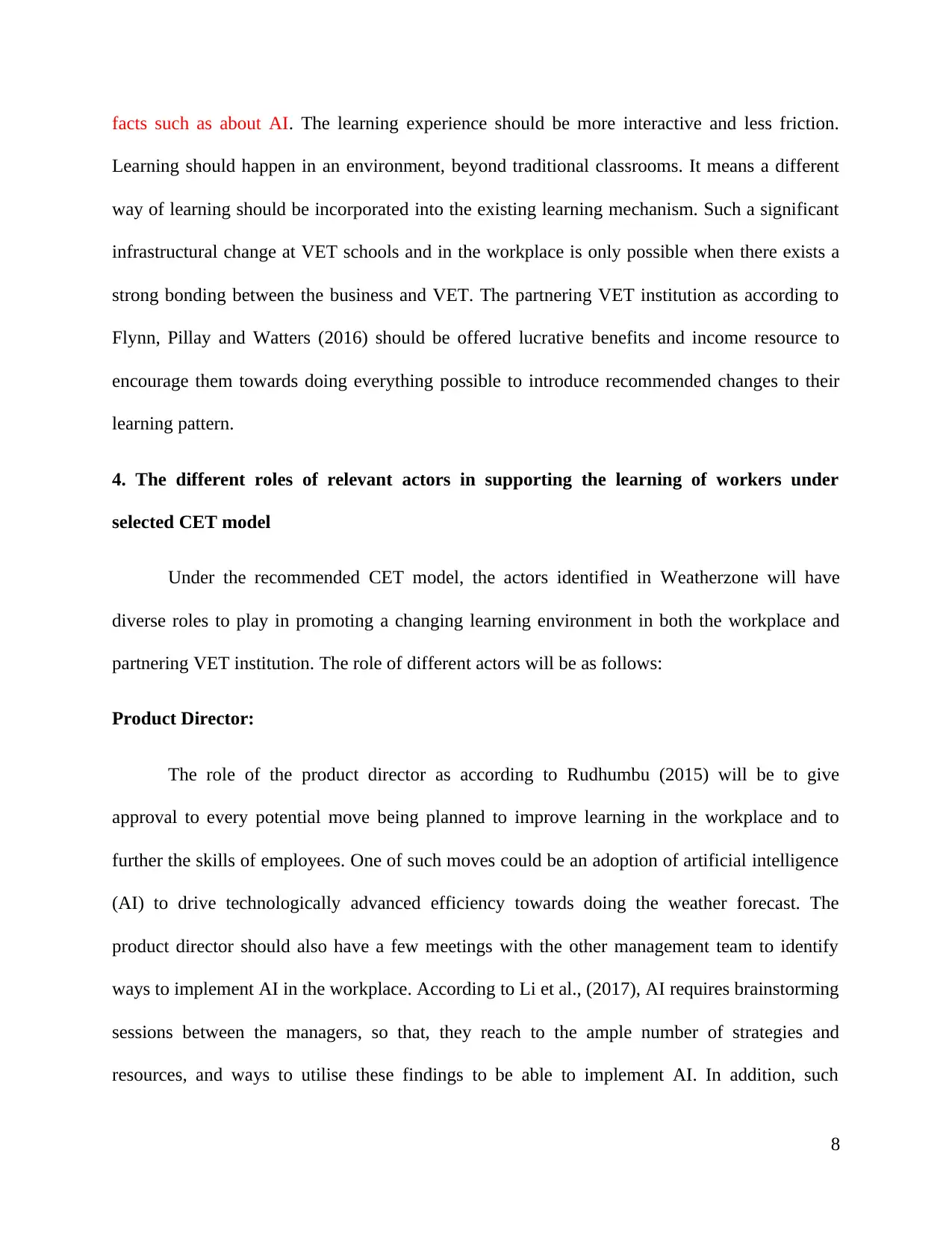
facts such as about AI. The learning experience should be more interactive and less friction.
Learning should happen in an environment, beyond traditional classrooms. It means a different
way of learning should be incorporated into the existing learning mechanism. Such a significant
infrastructural change at VET schools and in the workplace is only possible when there exists a
strong bonding between the business and VET. The partnering VET institution as according to
Flynn, Pillay and Watters (2016) should be offered lucrative benefits and income resource to
encourage them towards doing everything possible to introduce recommended changes to their
learning pattern.
4. The different roles of relevant actors in supporting the learning of workers under
selected CET model
Under the recommended CET model, the actors identified in Weatherzone will have
diverse roles to play in promoting a changing learning environment in both the workplace and
partnering VET institution. The role of different actors will be as follows:
Product Director:
The role of the product director as according to Rudhumbu (2015) will be to give
approval to every potential move being planned to improve learning in the workplace and to
further the skills of employees. One of such moves could be an adoption of artificial intelligence
(AI) to drive technologically advanced efficiency towards doing the weather forecast. The
product director should also have a few meetings with the other management team to identify
ways to implement AI in the workplace. According to Li et al., (2017), AI requires brainstorming
sessions between the managers, so that, they reach to the ample number of strategies and
resources, and ways to utilise these findings to be able to implement AI. In addition, such
8
Learning should happen in an environment, beyond traditional classrooms. It means a different
way of learning should be incorporated into the existing learning mechanism. Such a significant
infrastructural change at VET schools and in the workplace is only possible when there exists a
strong bonding between the business and VET. The partnering VET institution as according to
Flynn, Pillay and Watters (2016) should be offered lucrative benefits and income resource to
encourage them towards doing everything possible to introduce recommended changes to their
learning pattern.
4. The different roles of relevant actors in supporting the learning of workers under
selected CET model
Under the recommended CET model, the actors identified in Weatherzone will have
diverse roles to play in promoting a changing learning environment in both the workplace and
partnering VET institution. The role of different actors will be as follows:
Product Director:
The role of the product director as according to Rudhumbu (2015) will be to give
approval to every potential move being planned to improve learning in the workplace and to
further the skills of employees. One of such moves could be an adoption of artificial intelligence
(AI) to drive technologically advanced efficiency towards doing the weather forecast. The
product director should also have a few meetings with the other management team to identify
ways to implement AI in the workplace. According to Li et al., (2017), AI requires brainstorming
sessions between the managers, so that, they reach to the ample number of strategies and
resources, and ways to utilise these findings to be able to implement AI. In addition, such
8
⊘ This is a preview!⊘
Do you want full access?
Subscribe today to unlock all pages.

Trusted by 1+ million students worldwide
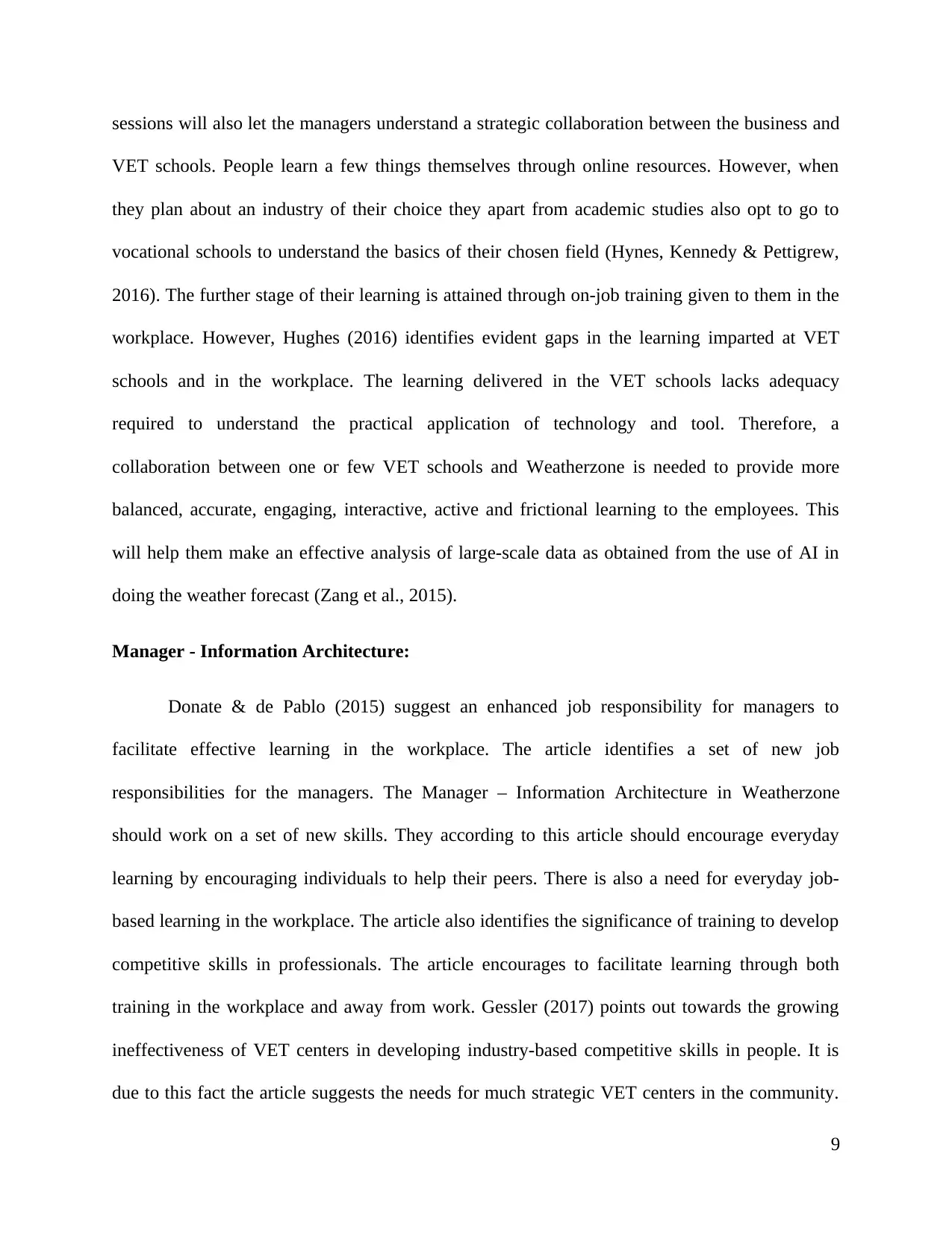
sessions will also let the managers understand a strategic collaboration between the business and
VET schools. People learn a few things themselves through online resources. However, when
they plan about an industry of their choice they apart from academic studies also opt to go to
vocational schools to understand the basics of their chosen field (Hynes, Kennedy & Pettigrew,
2016). The further stage of their learning is attained through on-job training given to them in the
workplace. However, Hughes (2016) identifies evident gaps in the learning imparted at VET
schools and in the workplace. The learning delivered in the VET schools lacks adequacy
required to understand the practical application of technology and tool. Therefore, a
collaboration between one or few VET schools and Weatherzone is needed to provide more
balanced, accurate, engaging, interactive, active and frictional learning to the employees. This
will help them make an effective analysis of large-scale data as obtained from the use of AI in
doing the weather forecast (Zang et al., 2015).
Manager - Information Architecture:
Donate & de Pablo (2015) suggest an enhanced job responsibility for managers to
facilitate effective learning in the workplace. The article identifies a set of new job
responsibilities for the managers. The Manager – Information Architecture in Weatherzone
should work on a set of new skills. They according to this article should encourage everyday
learning by encouraging individuals to help their peers. There is also a need for everyday job-
based learning in the workplace. The article also identifies the significance of training to develop
competitive skills in professionals. The article encourages to facilitate learning through both
training in the workplace and away from work. Gessler (2017) points out towards the growing
ineffectiveness of VET centers in developing industry-based competitive skills in people. It is
due to this fact the article suggests the needs for much strategic VET centers in the community.
9
VET schools. People learn a few things themselves through online resources. However, when
they plan about an industry of their choice they apart from academic studies also opt to go to
vocational schools to understand the basics of their chosen field (Hynes, Kennedy & Pettigrew,
2016). The further stage of their learning is attained through on-job training given to them in the
workplace. However, Hughes (2016) identifies evident gaps in the learning imparted at VET
schools and in the workplace. The learning delivered in the VET schools lacks adequacy
required to understand the practical application of technology and tool. Therefore, a
collaboration between one or few VET schools and Weatherzone is needed to provide more
balanced, accurate, engaging, interactive, active and frictional learning to the employees. This
will help them make an effective analysis of large-scale data as obtained from the use of AI in
doing the weather forecast (Zang et al., 2015).
Manager - Information Architecture:
Donate & de Pablo (2015) suggest an enhanced job responsibility for managers to
facilitate effective learning in the workplace. The article identifies a set of new job
responsibilities for the managers. The Manager – Information Architecture in Weatherzone
should work on a set of new skills. They according to this article should encourage everyday
learning by encouraging individuals to help their peers. There is also a need for everyday job-
based learning in the workplace. The article also identifies the significance of training to develop
competitive skills in professionals. The article encourages to facilitate learning through both
training in the workplace and away from work. Gessler (2017) points out towards the growing
ineffectiveness of VET centers in developing industry-based competitive skills in people. It is
due to this fact the article suggests the needs for much strategic VET centers in the community.
9
Paraphrase This Document
Need a fresh take? Get an instant paraphrase of this document with our AI Paraphraser
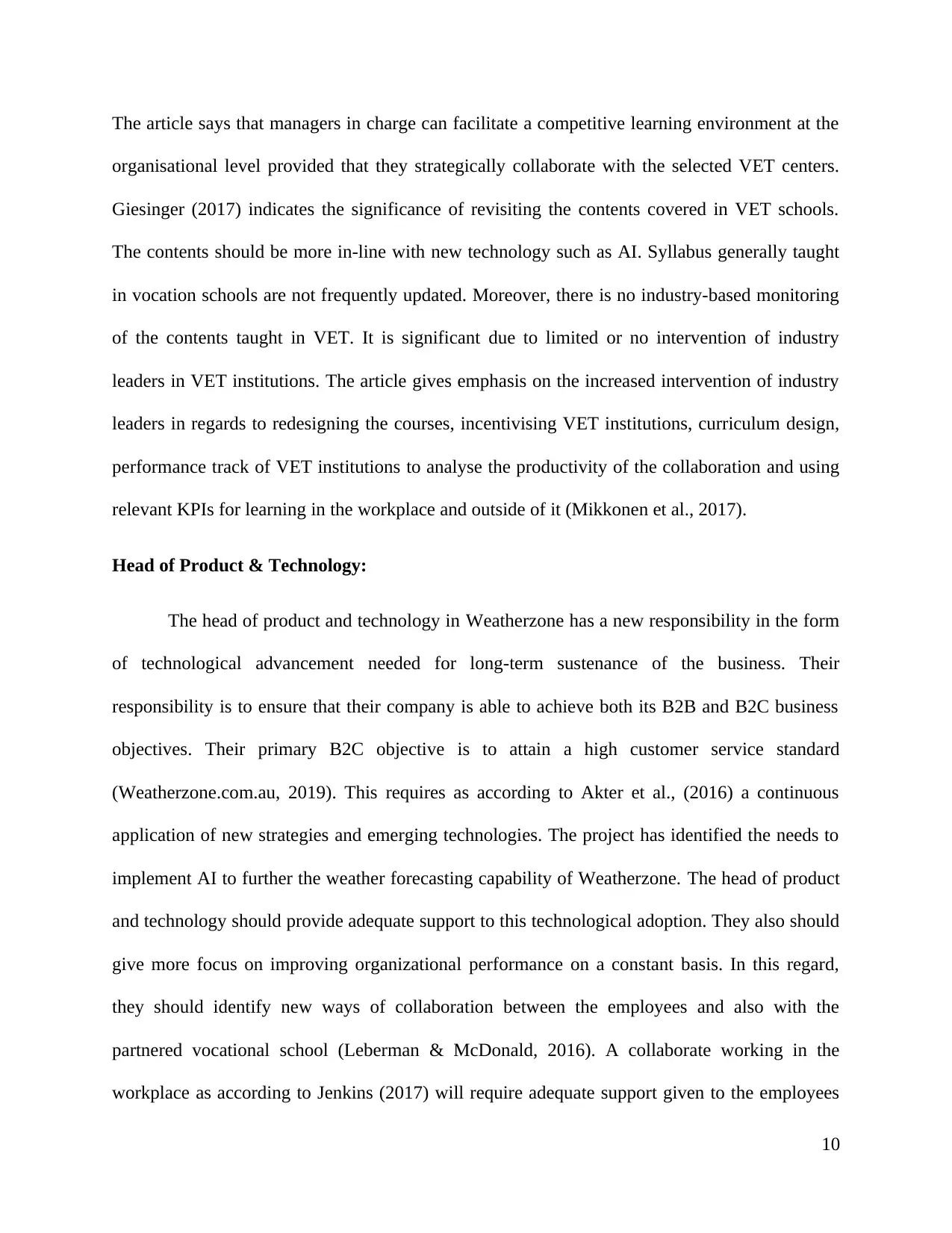
The article says that managers in charge can facilitate a competitive learning environment at the
organisational level provided that they strategically collaborate with the selected VET centers.
Giesinger (2017) indicates the significance of revisiting the contents covered in VET schools.
The contents should be more in-line with new technology such as AI. Syllabus generally taught
in vocation schools are not frequently updated. Moreover, there is no industry-based monitoring
of the contents taught in VET. It is significant due to limited or no intervention of industry
leaders in VET institutions. The article gives emphasis on the increased intervention of industry
leaders in regards to redesigning the courses, incentivising VET institutions, curriculum design,
performance track of VET institutions to analyse the productivity of the collaboration and using
relevant KPIs for learning in the workplace and outside of it (Mikkonen et al., 2017).
Head of Product & Technology:
The head of product and technology in Weatherzone has a new responsibility in the form
of technological advancement needed for long-term sustenance of the business. Their
responsibility is to ensure that their company is able to achieve both its B2B and B2C business
objectives. Their primary B2C objective is to attain a high customer service standard
(Weatherzone.com.au, 2019). This requires as according to Akter et al., (2016) a continuous
application of new strategies and emerging technologies. The project has identified the needs to
implement AI to further the weather forecasting capability of Weatherzone. The head of product
and technology should provide adequate support to this technological adoption. They also should
give more focus on improving organizational performance on a constant basis. In this regard,
they should identify new ways of collaboration between the employees and also with the
partnered vocational school (Leberman & McDonald, 2016). A collaborate working in the
workplace as according to Jenkins (2017) will require adequate support given to the employees
10
organisational level provided that they strategically collaborate with the selected VET centers.
Giesinger (2017) indicates the significance of revisiting the contents covered in VET schools.
The contents should be more in-line with new technology such as AI. Syllabus generally taught
in vocation schools are not frequently updated. Moreover, there is no industry-based monitoring
of the contents taught in VET. It is significant due to limited or no intervention of industry
leaders in VET institutions. The article gives emphasis on the increased intervention of industry
leaders in regards to redesigning the courses, incentivising VET institutions, curriculum design,
performance track of VET institutions to analyse the productivity of the collaboration and using
relevant KPIs for learning in the workplace and outside of it (Mikkonen et al., 2017).
Head of Product & Technology:
The head of product and technology in Weatherzone has a new responsibility in the form
of technological advancement needed for long-term sustenance of the business. Their
responsibility is to ensure that their company is able to achieve both its B2B and B2C business
objectives. Their primary B2C objective is to attain a high customer service standard
(Weatherzone.com.au, 2019). This requires as according to Akter et al., (2016) a continuous
application of new strategies and emerging technologies. The project has identified the needs to
implement AI to further the weather forecasting capability of Weatherzone. The head of product
and technology should provide adequate support to this technological adoption. They also should
give more focus on improving organizational performance on a constant basis. In this regard,
they should identify new ways of collaboration between the employees and also with the
partnered vocational school (Leberman & McDonald, 2016). A collaborate working in the
workplace as according to Jenkins (2017) will require adequate support given to the employees
10
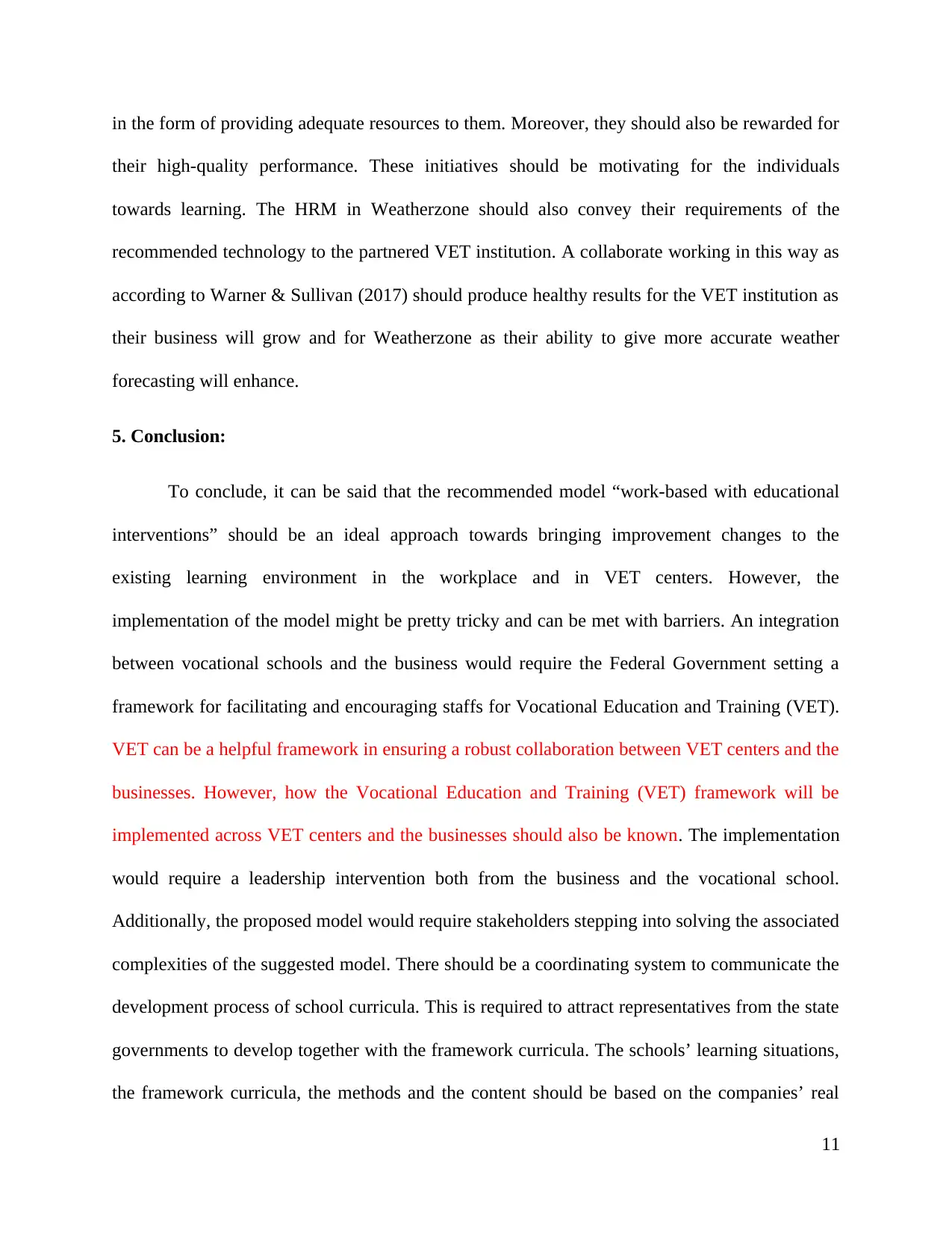
in the form of providing adequate resources to them. Moreover, they should also be rewarded for
their high-quality performance. These initiatives should be motivating for the individuals
towards learning. The HRM in Weatherzone should also convey their requirements of the
recommended technology to the partnered VET institution. A collaborate working in this way as
according to Warner & Sullivan (2017) should produce healthy results for the VET institution as
their business will grow and for Weatherzone as their ability to give more accurate weather
forecasting will enhance.
5. Conclusion:
To conclude, it can be said that the recommended model “work-based with educational
interventions” should be an ideal approach towards bringing improvement changes to the
existing learning environment in the workplace and in VET centers. However, the
implementation of the model might be pretty tricky and can be met with barriers. An integration
between vocational schools and the business would require the Federal Government setting a
framework for facilitating and encouraging staffs for Vocational Education and Training (VET).
VET can be a helpful framework in ensuring a robust collaboration between VET centers and the
businesses. However, how the Vocational Education and Training (VET) framework will be
implemented across VET centers and the businesses should also be known. The implementation
would require a leadership intervention both from the business and the vocational school.
Additionally, the proposed model would require stakeholders stepping into solving the associated
complexities of the suggested model. There should be a coordinating system to communicate the
development process of school curricula. This is required to attract representatives from the state
governments to develop together with the framework curricula. The schools’ learning situations,
the framework curricula, the methods and the content should be based on the companies’ real
11
their high-quality performance. These initiatives should be motivating for the individuals
towards learning. The HRM in Weatherzone should also convey their requirements of the
recommended technology to the partnered VET institution. A collaborate working in this way as
according to Warner & Sullivan (2017) should produce healthy results for the VET institution as
their business will grow and for Weatherzone as their ability to give more accurate weather
forecasting will enhance.
5. Conclusion:
To conclude, it can be said that the recommended model “work-based with educational
interventions” should be an ideal approach towards bringing improvement changes to the
existing learning environment in the workplace and in VET centers. However, the
implementation of the model might be pretty tricky and can be met with barriers. An integration
between vocational schools and the business would require the Federal Government setting a
framework for facilitating and encouraging staffs for Vocational Education and Training (VET).
VET can be a helpful framework in ensuring a robust collaboration between VET centers and the
businesses. However, how the Vocational Education and Training (VET) framework will be
implemented across VET centers and the businesses should also be known. The implementation
would require a leadership intervention both from the business and the vocational school.
Additionally, the proposed model would require stakeholders stepping into solving the associated
complexities of the suggested model. There should be a coordinating system to communicate the
development process of school curricula. This is required to attract representatives from the state
governments to develop together with the framework curricula. The schools’ learning situations,
the framework curricula, the methods and the content should be based on the companies’ real
11
⊘ This is a preview!⊘
Do you want full access?
Subscribe today to unlock all pages.

Trusted by 1+ million students worldwide
1 out of 19
Related Documents
Your All-in-One AI-Powered Toolkit for Academic Success.
+13062052269
info@desklib.com
Available 24*7 on WhatsApp / Email
![[object Object]](/_next/static/media/star-bottom.7253800d.svg)
Unlock your academic potential
Copyright © 2020–2025 A2Z Services. All Rights Reserved. Developed and managed by ZUCOL.




